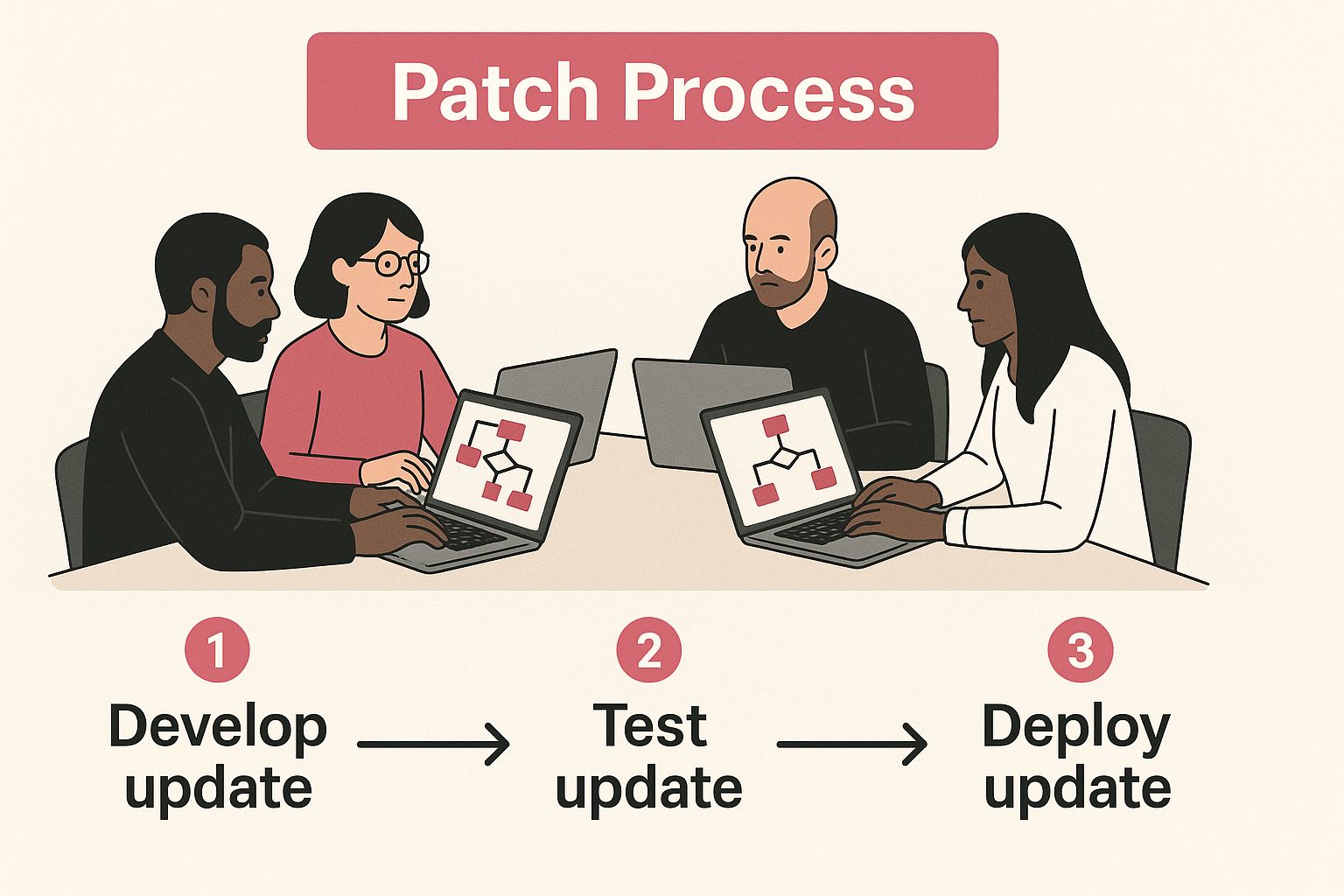Learn what is patch management and why it's vital for your business security. Discover strategies to protect your UK company today.

Think of your business’s software and operating systems as a digital building. Patch management is the ongoing maintenance that fixes the cracked windows, updates the security systems, and reinforces the locks before a burglar can get in. It is the process of finding, testing, and applying software updates (or patches) to seal up security holes and keep everything running smoothly.
In short, it is one of your most critical defences against the ever-present threat of a cyber attack.

At its heart, patch management is a disciplined, systematic way of looking after the software your business relies on every day. Every application, from your core operating systems to the specialised software your team uses, is built from millions of lines of code. With that much complexity, it is a simple fact of life that bugs and security vulnerabilities will pop up.
Software developers are constantly working to find and fix these issues, releasing patches to plug the gaps. The catch? It is up to you and your IT team to actually apply them.
Without a solid process in place, systems can go unpatched for weeks or even months. This leaves the door wide open for data breaches, ransomware attacks, and costly downtime. A proper patch management strategy ensures these critical fixes are applied quickly, safely, and in an organised fashion.
This is not just some technical box-ticking exercise; it is a fundamental business responsibility. Even so, many UK businesses find it a real challenge. Recent research reveals that a staggering 74% of UK businesses admit they cannot patch fast enough, with the average time to apply a patch dragging on for 102 days. You can dig into the full details of these patch management challenges facing UK businesses.
The best way to get a handle on this is to see it as a continuous cycle. Breaking it down into clear stages helps turn a potentially chaotic task into a manageable framework.
The table below summarises the essential lifecycle of a patch, from discovery right through to deployment. It provides a quick, high-level look at the process before we dive into the specifics of each stage.
Seeing the process laid out like this makes it much easier to understand how a vulnerability goes from being a potential threat to a resolved issue across your entire organisation.
Thinking of patch management as a tedious IT task is a common mistake. In reality, it is one of the most critical things you can do for your business's health and your clients' trust. For any professional services firm, where your reputation is your currency, ignoring software updates is like leaving the office doors wide open overnight. You are practically inviting trouble in.
At its core, consistent patching is your first and best line of defence against the most prevalent cyberattacks. Threats like ransomware, which can lock up your files and grind your business to a halt, thrive on finding and exploiting known weaknesses in software. Patches are the digital deadbolts that secure those vulnerabilities.
The risk of a security breach is not some far-off possibility; it is a daily reality for businesses across the UK. The latest figures are sobering: 43% of UK businesses reported a cyber breach in the last year, and that number skyrockets to 70% for medium-sized firms. Proactive patching directly tackles the exact gaps that attackers are looking for. You can learn more about the UK's current cybersecurity statistics to get a sense of the scale of the problem.
By applying security updates the moment they become available, you effectively shrink the window of opportunity for criminals. A system that is kept up-to-date is simply a much tougher target, encouraging attackers to move on to easier pickings.
Beyond the obvious security benefits, good patch management is vital for keeping your operations running smoothly. Software bugs can cause all sorts of headaches, from frustrating system crashes and slow performance to odd glitches that sap productivity. These might seem like small annoyances, but they accumulate, costing your team precious time and adding unnecessary stress.
Patches frequently contain bug fixes and performance tweaks that make your software run more reliably. That means fewer interruptions and a more stable working environment for your team, letting them focus on delivering for clients instead of fighting with their tools. This is a fundamental aspect of the wider responsibilities of a proactive IT support partner.
Here is a practical example: Imagine your law firm uses a document management system to handle sensitive case files. A vendor discovers a vulnerability that could let an outsider access confidential client information. Applying the security patch immediately does not just prevent a disastrous data breach; it also shows your clients you are serious about protecting their information and upholding solicitor-client privilege.
For any UK firm that handles client data, complying with regulations like GDPR is not optional. Keeping your systems patched and secure is a cornerstone of demonstrating that you are taking your data protection duties seriously.
A security incident caused by a missed patch can have cascading consequences:
Ultimately, a solid patching strategy is not just about IT. It is about protecting your firm’s finances, reputation, and future. It is tangible proof to both clients and regulators that you are a responsible custodian of their data.
Great patch management is not just a one-and-done task; it is a continuous, methodical cycle. For any professional services firm, mastering this lifecycle is the key to moving from a chaotic, reactive firefighting mode to a proactive, resilient security posture. Each stage logically flows into the next, creating a solid, repeatable process that keeps your systems and client data safe.
The journey always begins with discovery. It is a simple but powerful truth: you cannot protect what you do not know you have. This first step is all about building a complete inventory of every single piece of hardware and software on your network. We are talking servers, laptops, operating systems, and every application in between. A clear, up-to-date inventory is the bedrock of your entire security strategy. To get a handle on this foundational step, our guide on what is IT asset management is a great place to start.
Once you have that complete picture of your IT world, it is time to find and prioritise what needs fixing.
With a full asset list in hand, you can now scan everything for missing patches and known vulnerabilities. Automated tools are brilliant for this; they constantly check for new updates from vendors like Microsoft or Adobe and compare them against the software versions running in your business. The result is a clear list of potential weak points across your entire organisation.
But here is the thing: not all patches are created equal. This is where smart prioritisation comes into play. A vulnerability on your public-facing web server, for example, is a much bigger and more immediate risk than a minor bug in an internal-only marketing tool. That is why patches are usually sorted by severity:
This risk-based approach ensures your team focuses its energy where it matters most, tackling the biggest threats first.
The infographic below shows how these stages all fit together in a loop of continuous improvement, with IT professionals always reviewing the process to make it even more secure.

As you can see, patch management is not a one-off job but an ongoing cycle of discovery, testing, deployment, and verification.
Before you even think about rolling a patch out across the whole company, testing is an absolutely essential step. You would be surprised how often a new update can clash with existing software or a unique system setup, causing all sorts of unexpected headaches.
A poorly tested patch can cause far more disruption than the vulnerability it was supposed to fix. Testing in a controlled environment is your best defence against widespread downtime. For example, applying a Windows Server update without testing could break a critical application your finance team relies on, halting invoicing for days.
The right way to do it is to deploy patches to a small, representative group of test systems first. Let it run for a set period, and if no problems pop up, the patch gets the green light for wider deployment.
Finally, the deployment and verification stage is where the approved patch is rolled out to all relevant devices. Modern patch management tools can automate this, scheduling updates to run outside of core business hours to keep disruption to a minimum. The cycle is not truly complete until the final verification step, where you generate reports to confirm the patch was installed successfully on every single target machine. This closes the security gap and ensures you remain compliant.
Skipping software updates is a bit like leaving the front door of your business unlocked overnight. It is not a question of if something bad will happen, but when. The fallout from poor patch management is not just a minor technical issue; a single unpatched vulnerability can set off a disastrous chain reaction that puts your operations, finances, and entire reputation on the line.
The initial security breach is often just the tip of the iceberg. Cybercriminals are constantly scanning for these forgotten weak spots to get a foothold in your network. Once they are in, they can unleash ransomware, steal confidential client data, and trigger catastrophic downtime that grinds your business to a halt for days, or even weeks.
The consequences of a breach are both severe and wide-ranging. You are not just looking at operational paralysis. There are the potentially huge regulatory fines under GDPR for failing to safeguard client data, and that is before you even consider the astronomical costs of recovery, which can easily run into the millions. Even worse, the damage to client trust can be permanent.
We have seen plenty of high-profile examples right here in the UK. The NHS pathology partner, Synnovis, faced an estimated £32.7 million loss after a ransomware attack. The British Library reported recovery costs of around £6–7 million, with major disruption that dragged on for months. These are not isolated incidents; statistics show that exploiting known vulnerabilities as a way in for attacks shot up by 34% in just one year. You can dig deeper into the impact of these UK cybersecurity incidents to see just how serious the risk is.
A Cautionary Tale: An Accounting Firm Under Siege
Picture this: a reputable UK accounting firm, right in the thick of tax season. A critical vulnerability on their main server has been left unpatched for weeks. A ransomware gang finds it. Overnight, every client file—tax returns, financial statements, payroll records—is encrypted. The firm is completely paralysed.
This one oversight triggers a cascade of failures:
The firm is now staring down the barrel of a massive ransom demand, crippling recovery costs, regulatory penalties, and lawsuits from clients. The truly frustrating part? This entire crisis was preventable. A solid patch management process would have closed the door before the criminals ever got a look in. It is a stark reminder that many of the most damaging cyber security threats can be shielded by managed services.
Shifting from a reactive, "whack-a-mole" approach to a deliberate, strategic one is the first real step in mastering patch management. A solid strategy is not just about clicking "install updates"; it is about building a formal, repeatable process that shrinks your risk and boosts your efficiency. This means setting clear rules, defining roles, and making sure everyone on the team knows exactly what to do when a critical update lands.

At the heart of any modern strategy is a risk-based approach. Instead of treating every patch as equally urgent, you need to get smart about prioritisation. This is where systems like the Common Vulnerability Scoring System (CVSS) are a game-changer. It gives each vulnerability a standardised score, letting you see at a glance just how serious a threat you are dealing with.
Armed with this information, you can then establish clear Service Level Agreements (SLAs) that dictate how quickly patches must be rolled out based on their risk level. Think of these SLAs as the backbone of your policy—they turn good intentions into hard deadlines.
A well-defined SLA is your best defence against confusion and delay. It removes any guesswork and ensures your team responds with the urgency each threat deserves, creating a clear framework for both action and accountability.
A typical tiered SLA might look something like this:
A formal policy backed by clear SLAs transforms patch management from a chaotic scramble into an organised, predictable, and measurable security function. It is the difference between firefighting and fire prevention.
Of course, actually meeting these aggressive timelines, especially for critical patches, is next to impossible if you are doing everything by hand. This is where automation stops being a "nice-to-have" and becomes a strategic necessity.
Automation is the engine that powers a modern patch management strategy. Manual patching is painstakingly slow, riddled with opportunities for human error, and simply does not scale as your business grows. It is often the single biggest bottleneck in keeping systems secure, with countless IT professionals citing the sheer complexity of manual processes as a top challenge.
Automated tools cut through these problems by managing the entire lifecycle for you. They scan for missing updates, deploy the approved patches across your network, and even generate reports to verify that everything went smoothly. This frees up your skilled IT team from mind-numbing, repetitive work, allowing them to focus on bigger-picture initiatives that actually move the business forward.
The difference in efficiency, and more importantly, security outcomes between a manual and an automated approach is night and day.
The table below breaks down the key differences between sticking with a manual process and embracing automation. For most professional service firms, the advantages of an automated system quickly become obvious.
As you can see, automation is not just about convenience; it is about building a more resilient and secure business.
Finally, never underestimate the power of robust documentation. Keeping detailed records of every patch deployment, your testing results, and any exceptions you have had to make is crucial for internal governance. Plus, it proves invaluable during compliance audits, clearly demonstrating your firm’s diligent and professional approach to security.
Even with a great strategy on paper, the real world of patch management always throws up a few curveballs. Let us tackle some of the most common questions we hear from business owners and IT managers trying to get this right.
Getting these details sorted is what turns a good plan into a great one.
There is no single magic number here. The best way to approach this is with a schedule based on risk, not just a rigid calendar date. Your official policy should set clear timelines based on how severe a vulnerability is and how critical the system is to your business.
As a solid rule of thumb, you can start with this:
This tiered system means you are always reacting with the right level of urgency, putting out the biggest fires first while keeping routine maintenance manageable.
Unfortunately, yes. And this is exactly why testing is a non-negotiable step in any patching process. A poorly-coded or incompatible patch can clash with your other software or unique system settings, leading to anything from annoying glitches to a full-blown system crash. This is the single biggest danger of just blindly approving every update that comes along.
The only way to guard against this is to test every patch first. Deploy it to a small, isolated group of non-critical machines or a dedicated test environment. This lets you spot and fix any potential conflicts before you roll it out to the entire company, saving you from a massive headache and potential downtime.
It is easy to get these two mixed up because they are so closely linked, but they are distinct disciplines.
Think of it like this: vulnerability management is the detective work. It is the broad process of scanning your network to find, categorise, and prioritise security weaknesses. Its job is to find the problems.
Patch management, on the other hand, is the specific action you take to fix one of those problems. Applying a software update (the patch) is one of the most common ways to resolve a vulnerability that your detective work has uncovered. One finds the issue; the other applies the fix.
Automation is a game-changer for patch management—it is fast, efficient, and absolutely essential. But it is not a 'set and forget' silver bullet. The most effective strategies always blend the power of automation with skilled human oversight.
A tool cannot write your policy, test a patch for compatibility with your bespoke software, or make a judgement call when an update fails. Automation does the heavy lifting, but the strategy, verification, and critical thinking still need an expert at the helm. Think of it as a crucial piece of the puzzle, not the whole picture.
Navigating the world of patch management can feel complex, but you do not have to figure it all out on your own. At SES Computers, we provide expert managed IT support that transforms patching from a reactive chore into a proactive, strategic part of your defence. Contact us today to strengthen your security posture.